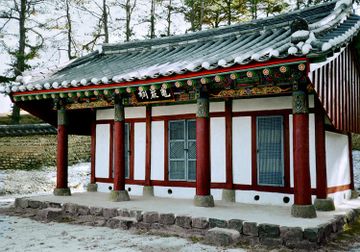"귀암사"의 두 판 사이의 차이
(새 문서: {{진행중}} {{문화유산정보 |사진=귀암사.jpg |사진출처=[http://www.heritage.go.kr/heri/cul/culSelectDetail.do?ccbaCpno=3413403010000 귀암사], 국가문화유산포...) |
|||
| 33번째 줄: | 33번째 줄: | ||
===영문=== | ===영문=== | ||
| + | '''Gwiamsa Shrine''' | ||
| + | This is a shrine where Yang Seong-ji (1415-1482), a civil official and a scholar of the early Joseon period was enshrined. | ||
| + | |||
| + | Yang Seong-ji passed the state examination in 1441 and served six kings for more than forty years with various government posts. He stressed the autonomy of Joseon and insisted on learning its own history independent from China, tracing its origin to Dangun. He was also dedicated to making practical policies such as establishing medical offices in each province and strengthening national defense. | ||
| + | |||
| + | Gwiamsa Shrine was originally built in Seodanggol in 1822. Due to a flood, it was relocated to the current place in 1883 and repaired in 1923. A stele recording Yang’s life and achievements was erected in 1933. A pavilion to house the stele was built in 1973. In front of this pavilion, there still remains a stone shaped in a turtle, which became the name of the shrine, “gwiam (turtle stone).” | ||
| + | |||
| + | *외국인들에게 단군을 어떻게 설명할까요? | ||
| + | *귀암사 이름의 유래가 된 거북 모양의 바위는 양성지와 무슨 관련이 있나요? | ||
===영문 해설 내용=== | ===영문 해설 내용=== | ||
2019년 10월 7일 (월) 00:45 판
| 귀암사 Gwiamsa Shrine |
|
 귀암사, 국가문화유산포털, 문화재청. |
|
| 대표명칭 | 귀암사 |
|---|---|
| 영문명칭 | Gwiamsa Shrine |
| 한자 | 龜岩祠 |
| 주소 | 충청남도 금산군 평촌1길 2 (부리면) |
| 지정번호 | 문화재자료 제301호 |
| 지정일 | 1988년 8월 30일 |
| 분류 | 유적건조물/인물사건/인물기념/사우 |
| 수량/면적 | 2동 |
| 웹사이트 | 귀암사, 국가문화유산포털, 문화재청. |
|
|
|
해설문
국문
귀암사는 조선 세종 때부터 성종 때까지 40여 년간 집현전 학사, 이조판서, 공조판서, 홍문관 대제학, 예문관 대제학, 사헌부 대사헌을 두루 거친 문양공 양성지(梁誠之, 1415~1482)를 모시기 위해 세운 사당이다.
양성지의 호는 눌재(訥齋)이다. 그는 현실적인 정책을 펼친 인물로 민생을 위해 각 지방에 의료기관 설치를 주장하였고, 우리나라 고유의 풍습이 중요함을 강조하였으며 과거 시험을 현실에 맞게 바꾸길 요구하였다. 그의 6대손인 양응해는 선조의 뜻을 이어가기 위해 귀암사에 사숙(私塾)*을 열어 향토 교육에 이바지하였다.
귀암사 사숙은 원래 서당골에 있었으나 홍수가 일어나 1883년(고종 20)에 지금의 위치로 옮겨와 고쳐 지었고, 1923년에 현재의 모습을 갖춘 것으로 알려져 있다. 1933년에는 양성지의 일생과 행장 및 공훈을 기록한 ‘눌재양선생묘비(訥齋梁先生墓碑)’를 세웠고, 1973년에는 비각을 세웠다. 비각 앞에는 거북 모양의 바위인 ‘귀암(龜巖)’이 지금도 남아 있다.
- 사숙(私塾): 한문을 가르치던 글방
영문
Gwiamsa Shrine
This is a shrine where Yang Seong-ji (1415-1482), a civil official and a scholar of the early Joseon period was enshrined.
Yang Seong-ji passed the state examination in 1441 and served six kings for more than forty years with various government posts. He stressed the autonomy of Joseon and insisted on learning its own history independent from China, tracing its origin to Dangun. He was also dedicated to making practical policies such as establishing medical offices in each province and strengthening national defense.
Gwiamsa Shrine was originally built in Seodanggol in 1822. Due to a flood, it was relocated to the current place in 1883 and repaired in 1923. A stele recording Yang’s life and achievements was erected in 1933. A pavilion to house the stele was built in 1973. In front of this pavilion, there still remains a stone shaped in a turtle, which became the name of the shrine, “gwiam (turtle stone).”
- 외국인들에게 단군을 어떻게 설명할까요?
- 귀암사 이름의 유래가 된 거북 모양의 바위는 양성지와 무슨 관련이 있나요?
영문 해설 내용
귀암사는 조선 초기 학자이자 문신인 양성지(1415-1482)를 모신 사당이다.
양성지는 1441년 과거에 급제한 후 총 40여 년간 6명의 왕을 섬기며 여러 관직을 역임하였다. 그는 조선의 자주성을 강조하며 단군에서부터 비롯하는 동국사(東國史)를 배울 것을 역설하였으며, 국방 강화에도 힘썼다. 또한 민생을 위해 각 지방에 의료기관을 설치할 것을 주장하는 등 현실적인 정책을 펼친 인물이다.
귀암사는 원래 1922년 서당골에 세워졌다. 그러나 홍수로 인해 1883년 지금의 위치로 옮겨와 고쳐 지었고, 1923년에 보수되었다. 1933년에는 양성지의 일생과 업적을 기록한 비를 세웠고, 1973년에 비각을 세웠다. 비각 앞에는 거북 모양의 바위인 ‘귀암’이 지금도 남아 있다.